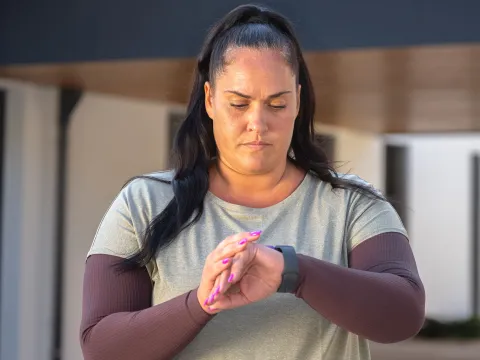- AdventHealth

During the opening kickoff of Alabama’s recent game against Tennessee, star wide receiver Jaylen Waddle suffered an ankle injury described by Alabama coach Nick Saban as a “combination of a high-ankle sprain and fracture.”
Saban confirmed that Waddle will be out for the remainder of Alabama’s season after his foot got caught between the grass and the body of his opponent. Waddle was not able to put weight on his right foot as he was helped off the field and eventually taken by cart into the locker room. Waddle, who is a junior this year, has been highly regarded as an NFL draft prospect.
With a season-ending injury like this, there’s not only physical damage, but a mental impact — as a student-athlete sees his professional sports career in jeopardy.
Waddle’s Ankle Injury
We don’t know yet the specifics of Waddle’s injury, aside from his coach saying it is both a sprain and a fracture.
“A sprain occurs when a ligament (connective tissues, like elastic bands that connect the end of one bone to another and also keep your joints in place) is stretched or torn. It's common to feel a pop or tear when this happens,” says AdventHealth Sports Med and Rehab Clinic Manager David Garcia PT,DPT, OCS.
A sprained ankle can occur when your foot turns inward, placing extreme tension on the ligaments of your outer ankle.
The signs of a sprain can include:
- Bruising
- Decreased range of motion
- Instability of the joint
- Pain
- Swelling
When it comes to an ankle fracture, the healing process can take a bit longer and may require surgery — depending on the type and severity of the fracture. When a bone gives way and breaks, that’s a fracture, versus when the ligaments tear, which would be a sprain.
“In the ankle, there are three different bones that can be fractured: the tibia, fibula and/or talus,” says Garcia. Most commonly, breaks of these bones occur when there’s a sharp ankle twist or direct impact.
“There are things that you can do in the first 24 to 48 hours after an ankle injury to help alleviate pain and begin the healing process. You should rest, protect the injured area, use crutches or other assistive devices as needed to help immobilize, compress (not too tight), elevate, and apply ice for 15 to 20 minutes at least every two hours,” says Garcia.
Sprains can sometimes be treated at home, but in the case of a fracture or if you don't see any improvement, we recommend seeing a medical professional to evaluate the extent of your injury.
How Injuries Affect Mental Health of Athletes
With a player like Waddle who could have a future in professional sports, a season-ending injury could impact more than just his physical health. According to the National Collegiate Athletic Association (NCAA), “For some student-athletes, the psychological response to injury can unmask serious mental health issues, such as depression, anxiety, disordered eating and substance use or abuse.”
Some common emotional responses to a student-athlete injury include:
- Anger
- Change in appetite
- Disengagement
- Frustration
- Irritation
- Isolation
- Lack of sleep
- Sadness
While emotional reactions to injuries can be normal and are expected, the student’s physician and loved ones should pay close attention to these emotions that may get worse or last for a long period of time. It’s important to let the injured player know that their mental health needs care just as much as their physical injuries.
Providing support to injured student-athletes can help them feel like they’re still part of the team and keep them engaged.
Preventing Ankle Injuries
Regular stretching and strengthening exercises can help minimize the risk of injury and improve motion in all areas of the body. You can use a variety of stretching techniques to make sure you have full range of motion at all joints and lessen your chances of injuries, too.
Progressive strengthening exercises allow you to better stabilize yourself during activity. Balancing exercises train your body to know where it is in space and reduce your injury rate.
Other tips for preventing an ankle injury include:
- Be in the right physical condition for the sport you're playing
- Eat healthy to keep your muscles strong
- Exercise daily
- Keep a healthy weight
- Keep your home safe to prevent slips and falls
- Run on flat surfaces to prevent tripping
- Try to exercise or play sports when you're alert and not tired
- Wear protective gear when playing sports
- Wear the right shoes for the sport you're playing
For more information about sports injuries or to request an appointment with a physical therapist, call
Call833-787-6755 or visit AdventHealth Sports Med and Rehab.




